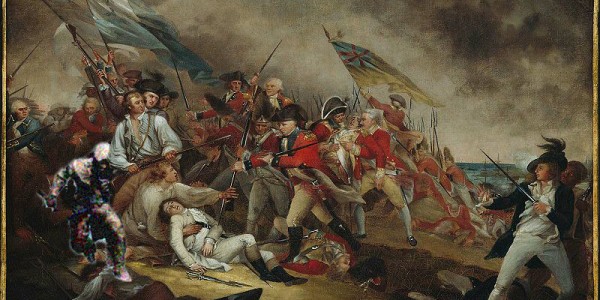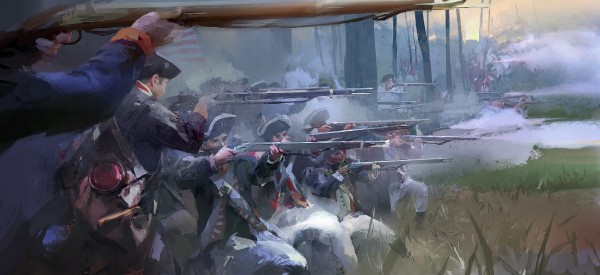We stepped back into the pungent people-sea of the PAX East 2012 show floor, and my colleagues remarked on an Assassin’s Creed III hands-off demo and the game’s apparent play revisions since Revelations.
“Oh, god, and the rope-dart hanging? So brutal!”
“Nah, it’s all about tree navigation, man – being a part of and apart from nature.”
“Yeah, but those pistol and hatchet double-counter executions were insane!”
“What about Pitcairn?” I said. “Didn’t we just see him take Connor’s tomahawk to the throat? I thought he survived the battle. He died shortly after, but made it off the field, right?” The reply revealed what I’d come to expect about the perception of details in the AAA historical-fiction open-world stealth-action videogame series.
“Eh, it’s close enough.”
Since 2007, Ubisoft has painstakingly begun to dismantle history at its glowing weak spot: speculative details. In working on three games spanning the era of Middle Eastern religious warfare (known as The Crusades) and five games covering Europe’s resurgence in art, thinking, and political incest (known as The Renaissance), the Assassin’s Creed series’ developers have been meticulous about their re-imagined histories, and have taken full advantage of the still-malleable casts of historical reliefs marred by isolated accounts, suspect accounts, or the quagmire of accounts in the oral tradition. Like so many of Ezio’s loyal blacksmiths, these game designers bend blades to their cause, crafting instruments of serial homicide to empower the player on a virtual bloodletting in history’s sandbox. They are at once intensely respectful of the past they explore and inherently exploitative.
I’m sure you’re still worrying over poor, deceased John Pitcairn, so let me assure you that, no matter the historian, he’s dead. Ubisoft has not been so bold in retelling the pivotal moments of the American Revolution in Assassin’s Creed III through the eyes of a half-Mohawk, half-English patriot that it rips entire pages from the bindings of textbooks. And the trouble isn’t in that Pitcairn met his end shortly following the Battle of Bunker (or Breed’s) Hill, but rather how he sustained the injuries that brought about that end. Historians argue that one of two black soldiers (Peter Salem or Salem Poor) did the deed, at a distance via musket, during the heat of battle, solidifying their reputations as national heroes and early champions for military racial equality. The primary evidence is a 1786 painting by John Trumbull depicting an African-American soldier as the “unwitting perpetrator” and some loose oral account relating to the name “Salem.” Ubisoft says, well, that you’ll kill him.
I wouldn’t presume to say that the Assassin’s Creed series hinges on realistic historical accounts, because supernatural Pope-brawling falls well outside history’s jurisdiction, among other instances. There does, however, seem to be a preoccupation in these games with the details surrounding central figures of the major conflicts, only to arbitrary degrees. (This ignores all the science-fiction of how the player actually gets inserted into history through ancestral DNA virtualization, and that sticky business with the apples, staffs, and Subject 16, to be sure.)
Take, for example, Robert de Sablé, Grand Master of the Knights Templar during the Third Crusade and chief antagonist in the first Assassin’s Creed, who is killed at the player’s hand in digital 1191 and by the hand of aging in real 1193. In the digital timeline, the very actual Robert de Sablé never would have ruled Cyprus long enough to pass it along to Guy of Lusignan, who would then never lay the framework for a full-scale invasion of the island-state in the 16th century, thus butterfly kissing a snowball effect straight through Mediterranean history. Molehills, mountains, and so on.
In Assassin’s Creed III, when the scene at Bunker Hill comes into view, and colonial general William Prescott shouts the infamous “whites of their eyes” speech to a ragged formation of makeshift militia, soon overtaken by the breathtaking hillside of red coats obscured by a musket-produced “fog of war” (actually where the term comes from), the responsibility of this detail-burdened recreation becomes apparent. Ubisoft has lost the luxury of an unclear era. The American Revolution is more than just well-tread historical ground – to some, it’s outright sacred. That level of demanding precision can only mean a likewise adjustment in representational media (The Patriot notwithstanding).
This leads to the principle distinction between Assassin’s Creed III‘s preview and the stories of Ezio and Altair; it’s the presumption of tongue-in-cheek plausibility. A subterranean Vatican chamber holding the secrets of the universe conjures enough blasphemy to become comically fictitious in Assassin’s Creed II. The assassination of a British commander during the frenzy of battle by a lone assassin, countered only by weak third-person testimony appears to be viably non-fiction. The more believable a setting, its characters, and their interactions become, the more these details matter. And the more these details matter, the further Ubisoft drifts from telling an original, inventive story to History Channel Civil War: A Nation Divided, a greater travesty than even Ancient Aliens.
How, then, does a development team respect this new burden, meeting it with equal parts enthusiasm, research, and gallons of Templar blood? Can history be translated directly into game without losing the honesty that makes it history? Historical fiction will always walk that thin wire strung taut between it’s defining elements; the question is, “When does it fall off?”
Gamers will likely be amicable to Pitcairn’s melee execution if they’re willing to forgive the trespass of – oh, I don’t know – a machine gun in the 15th century. Perhaps Assassin’s Creed is already so deeply fictitious that it’s historical nods, however concerted, are no more than dubious Easter eggs. Any other interpretation would attempt to shoehorn the narrative’s unwieldy bits into the peevish historian’s crowded loafers, while the elements of play, the “predator fantasy” of Assassin’s Creed, won’t even blink at the gesture. Climbing, sneaking, stabbing, exploring, eagle-crying, and gently pushing through crowds form the addictive base of the series’ reputation, irrespective of some historical gerrymandering. Ubisoft must have decided early on that in the matter of preserving the often-tedious details of the past, its response would (and rightly should) be:
“Eh, it’s close enough.”




















Great piece. I do think though that Ubisoft can also say, “The Templars used their power to change ‘what really happened’ into the well-known historical accounts.” Secret societies are a nice excuse like that.